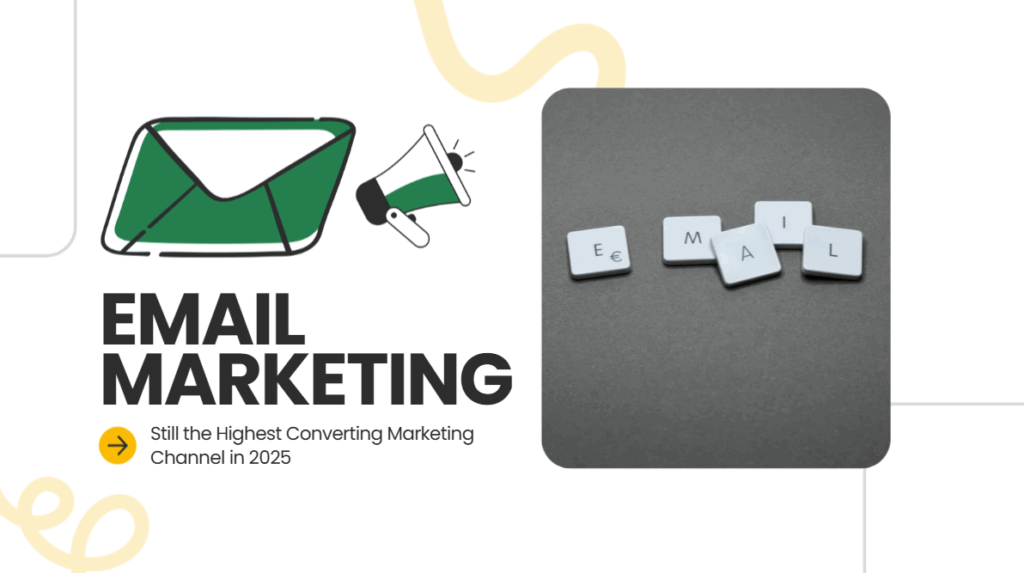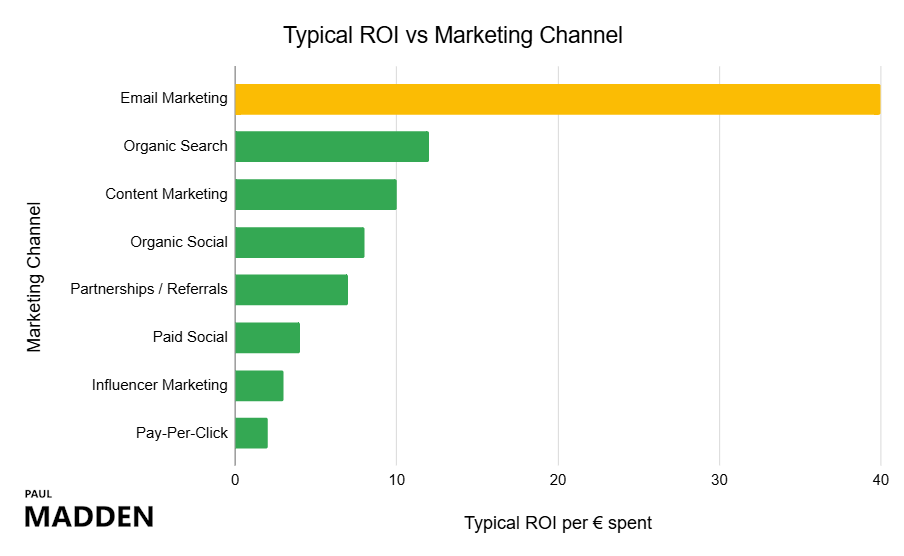
Knee-jerk marketers look away now — email is still number one for converting customers and is unrivalled for return on marketing spend. With social media algorithms changing more frequently than the weather, advertising facing regulatory challenges and the influencer influenza resulting in more cold chills than consistent customers, one marketing channel has remained steadfastly effective — good ‘old fashioned’ email! The data doesn’t lie — email marketing return on investment is up to 40:1 — nearly 4 times higher than the next highest channel which is organic search.
If you are a small business owner and email marketing is not central to your marketing strategy, then you really need to rethink how your marketing budget is spent. Let’s take a closer look at why email marketing is still the most effective marketing channel by far.
According to Shopify’s research, 87% of marketing professionals say email is critical to the success of their company with 63% saying the volume of emails they send is increasing. The second statistic suggests it’s also getting harder to stand out from the noise — so it’s more important than ever to have a well-thought out email marketing strategy focused on delivering the right message at the right time with a compelling offer.
Success isn’t dependent on big budget capabilities either. Platforms like MailChimp and Google Analytics make the provability of email as an effective marketing channel very accessible, even to small businesses on a tight budget.

Email consistently delivers a 40:1 return on investment, outperforming all other channels by a considerable distance. These statistics are consistent across B2B and B2C markets with retail, e-commerce and consumer goods showing a return of up to $45 per dollar spent.
73% of B2B marketers say that email outperforms other methods such as phone calls, events and ads when it comes to reaching their target customer.
The integration of Artificial Intelligence (AI) into email marketing has revolutionised personalisation. AI tools now enable marketers to customise email content based on user behaviour and preferences, automating the process of data analysis and segmentation and ensuring messages resonate with recipients. This approach not only boosts engagement but also strengthens customer relationships.
This data-driven marketing automation also drives repeat purchases and customer onboarding with customisable workflows now a standard offering across many software platforms.
Email stands alone when it comes to retaining a captive audience. Firstly, prospective customers give consent — they opt-in to your communications. Similar to organic search, they have declared their intent to some degree — the same cannot be said of other channels where intent is unknown. Changes to social media algorithms throttle engagement and that unpredictability makes it difficult to build a sustainable strategy.
The direct, unfiltered access to your target market offers an unrivalled opportunity to make your pitch or nurture prospects through your sales funnel for longer sales cycles.
Everybody has an email address (or nearly everyone), yet social media platform audiences are more transient and seem to age more rapidly. Whether your target audience is Gen Z, Millennials, Gen X or Baby Boomers, chances are, they check their email regularly — with notifications on phone, watch etc. . In fact, 88% of people check their email several times a day. That’s a massive, built-in habit you can tap into — no need to train users to engage. This versatility across all demographics makes email — dare I say it — irreplaceable in the current marketing landscape.
The advent of General Data Protection Regulation (GDPR) in 2018 caused a degree of panic with respect to how businesses handled customer data. Some businesses fearing the risk of GDPR related fines, including Wetherspoons in the UK, dumped entire mailing lists citing “intrusiveness” as the reason for this drastic action. Whether this decision was right or wrong, it showed that GDPR was a game changer for the approach to email marketing, heralding a new era of consent-based marketing.
Seven years later email persists as the number one conversion channel for B2B and B2C businesses. The fact that it is now done in a compliant fashion just boosts its credibility. The integration of AI and automatable workflow also makes it a must-have tool for scaling customer communication throughout the marketing funnel.

Email alone is no silver bullet. Your marketing strategy needs to be more holistic, utilising an appropriate mix of all available touchpoints to engage your target customer, build trust and drive conversions. Email can be effective throughout the sales & marketing funnel — perhaps most effectively at the Consideration Stage where potential customers are still on the fence and evaluating their options. There is a clear, unobstructed opportunity to convey value — depending on the nature of the purchasing decision, there may be an opportunity to get into a lot of detail as the level of attention is highest during this evaluation stage.
With a potential 40:1 return on investment, email is still the clear #1 marketing channel and isn’t going anywhere soon! Regardless of your industry and even if you are starting from scratch in 2025, email represents a significant opportunity to grow your brand and build sales volume with a plethora of tools offering a high level of scalability, allowing for increased margins at a low level of risk.
To provide the best experiences, we use cookies to store and/or access device information. Consenting to cookies will allow us to process data such as browsing behaviour or unique IDs on this site. Not consenting or withdrawing consent, may adversely affect certain features and functions.